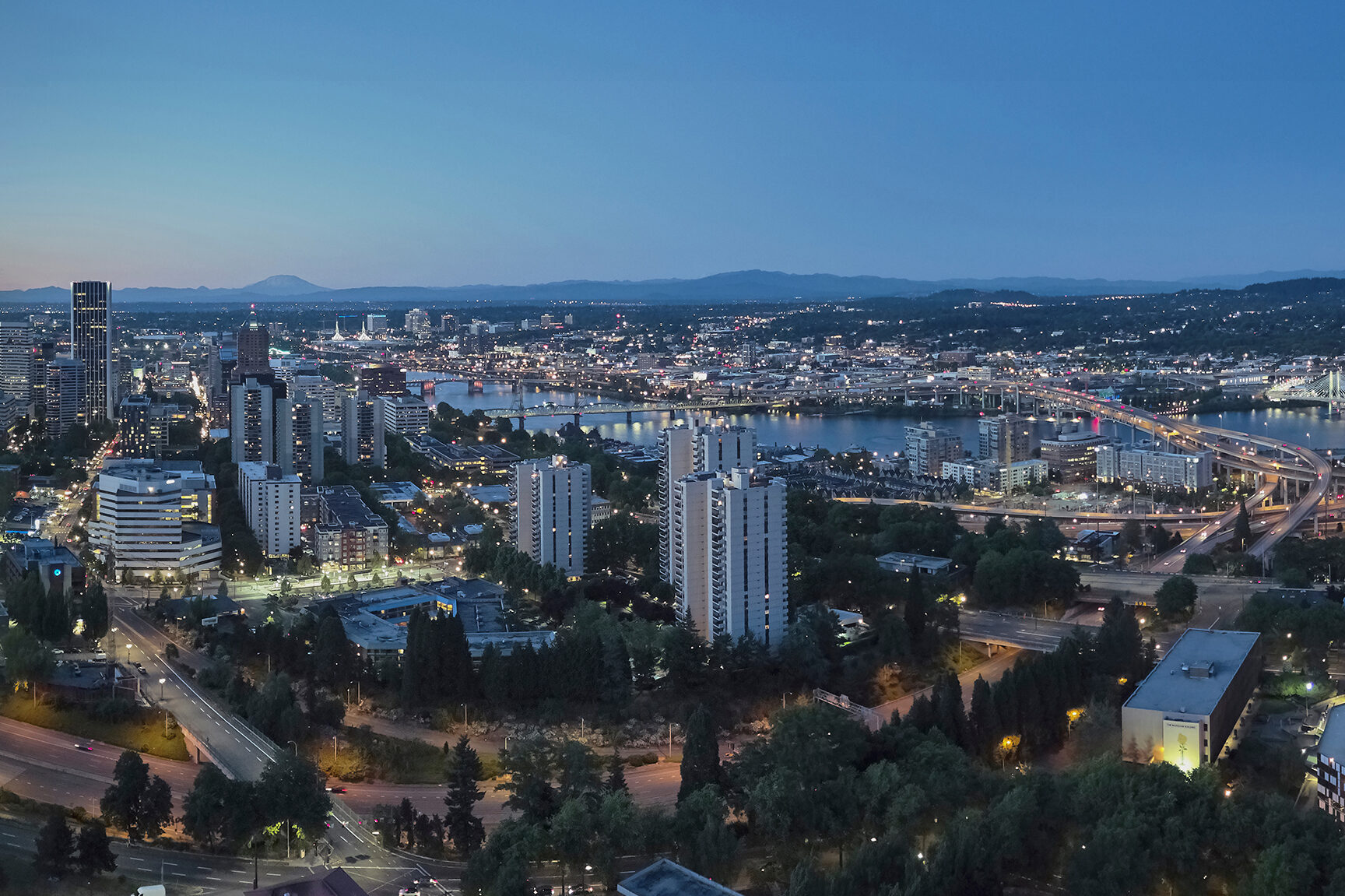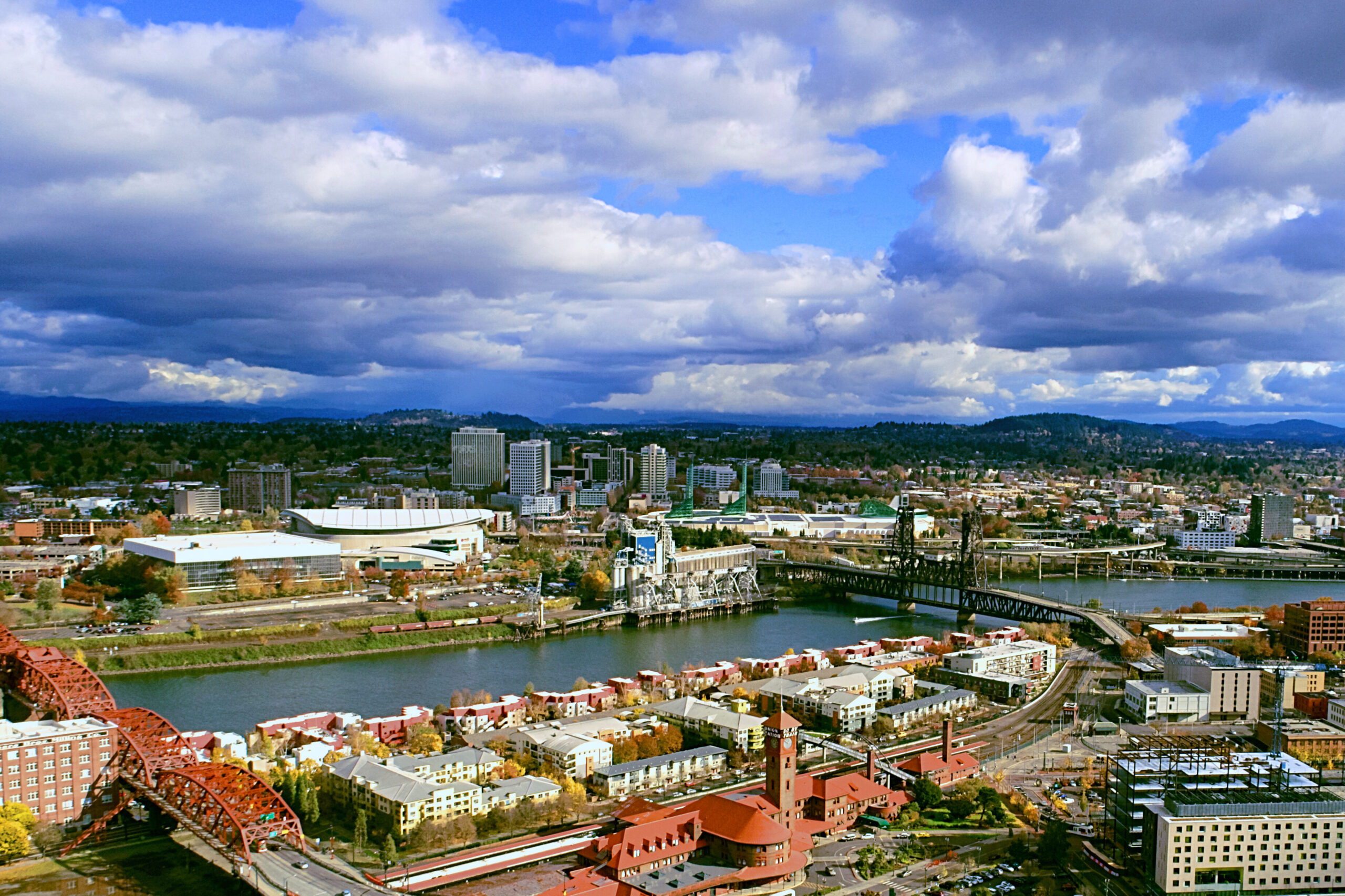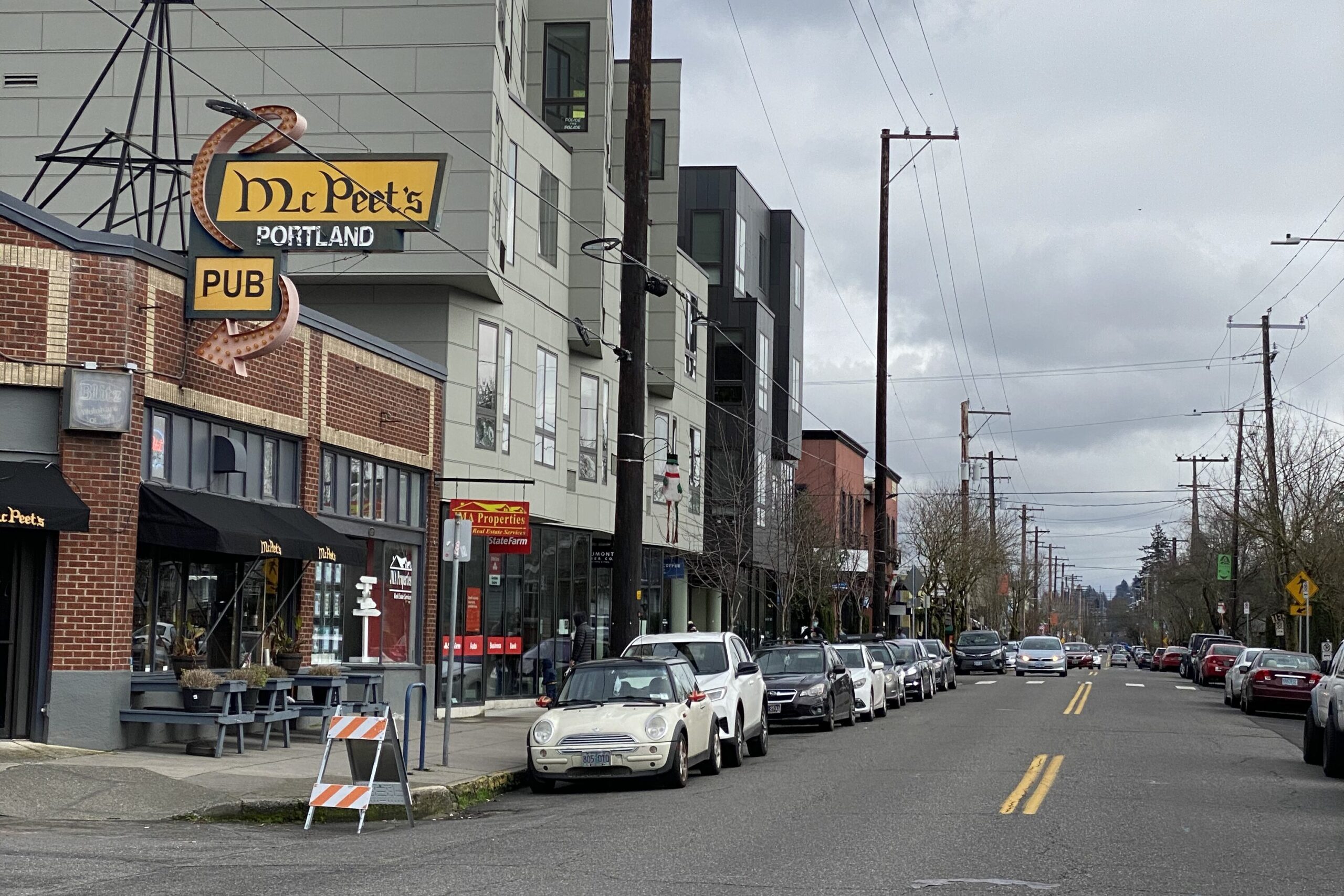Full Report
Last year’s report tracked the 2022 economy that marked the end of the Covid public health emergency, and it was time to take stock. 2023 began with the State of the Economy, and it was a “doozy”. A sizable population loss in Multnomah county, weak foot traffic recovery in downtown Portland, and slowing apartment construction were among the headlines.
Our 2023 report foreshadowed even bleaker assessments that would appear in the national media; paired with widely circulated articles featuring common themes of our preeminent challenges like homelessness, open drug use, retail theft, and population decline. The media made Portland emblematic of the nation’s post-pandemic challenges.
The severity of the economic and social problems led to the creation of a public-private task force led by Governor Tina Kotek and the CEO of the Standard, Dan McMillian that aimed to quickly improve conditions in Portland’s Central City. The four-month effort was action-oriented and advanced ten, near-term recommendations, including a tri-government fentanyl health emergency, an expansion of the emergency shelter system, a public-private partnership to clean up trash and graffiti, and a moratorium on new taxes. Implementation is underway as this report goes to press.
While the Portland narrative was often downbeat, the year was not without its good news. In a concerted effort to revitalize Portland’s Central City, local leaders are spearheading several initiatives, such as City Council’s adoption of the Downtown Business Incentive credit program to incentivize commercial leases. These leaders are collaborating to reinstate basic services and are aligning efforts with interventions at the state and federal levels.
Early in the 2023 legislative session, state lawmakers enacted a $240 million Oregon companion to the federal CHIPS Act with an aim of bolstering the region’s semiconductor sector. Governor Kotek’s office announced that companies applying for the state money sought to invest $43 billion in coming years–much of it in the Portland region. The announcements bolstered the state’s revenue outlook.
This edition of the State of Economy starts a new era in our analysis as we stabilize into a new normal. Therefore, we will no longer compare ourselves to 2019 and establish 2024 as the Greater Portland regional economic baseline.
The following report offers some modest improvements over last year’s check up, but on critical measures like population growth and housing production, the region still has a long way to go. Perhaps the best news is that elected and business leaders enter 2024 with an agreed-upon list of remedies courtesy of the Governor’s task force. Take productive action on those, and the community can look forward to a better report next year.
Report at a Glance
1.3%
Portland metro job growth in 2023, below U.S. average.
4.1%
Jobs gained in the Leisure & Hospitality sector, slower than 10.4% from 2022.

11,000
Jobs lost in the Professional Services, Manufacturing & Information sectors.
8%
Premium to live in Portland when adjusting median household income, driven mostly by high cost of housing.
26%
Growth of local revenue collection from 2010-2020, only surpassed by Seattle.
Economic Data
The troubling population trends continued in 2022 with declines in Multnomah and Washington counties, no growth in Clackamas county, and a modest increase in Clark county. The latest census figures underscore the importance of net migration to the region’s population trends–only Washington County shows sizable natural population growth (that is, births outnumbering deaths). Unpacking the drivers of the weak population numbers will take time, but leading candidates include ongoing adjustments to work-from-home, an unaffordable housing market, and responses to an abrupt increase in taxation since 2019. See Figure 1.
The Portland region tends to grow jobs at a faster rate than the U.S. during economic expansions and that’s been the case recently. After subpar growth in 2021, due in large part to restrictive Covid policies, job growth in the region outpaced the U.S. in 2022 then reversed course and lagged in 2023. This reversal is unique for Portland, which has historically outpaced U.S. job growth especially when climbing out of economic recessions. See Figure 2.
All counties have recovered to their pre-pandemic employment levels with the exception of Multnomah County. The job growth trends mirror population trends with Clark County leading the region, Multnomah County trailing and Washington and Clackamas Counties falling between the two. Clark County’s growth has been aided by land availability and the widely praised redevelopment of the Vancouver waterfront. Multnomah County, on the other hand, has seen a slow recovery of the leisure and hospitality sector–especially in Downtown Portland. See Figure 3.
Local governments–cities, counties, school districts, special districts–matched the March 2020 employment level in March 2023 (123,000) and then added almost 5,300 additional employees through December. Private education and health services, too, returned to pre-pandemic staffing levels. Leisure and hospitality also grew by 4.1%, although lower compared to 10.4% in 2022.
Manufacturers had an off-year as consumers shifted away from their pandemic-related goods purchasing and focused more on services. The declines in the information sector mirror national trends and are driven, in part, by layoffs in the tech sector. While information-related employment declined by over 10%, the change only reflects 2,800 jobs. See Figure 4.
Growth in median household income has been good news for much of the last decade–and that continues again this year. The 2017-2022 period saw gains for all but one racial/ethnic group, American Indian, Alaska Native, Hawaiian and Pacific Islanders. Household income growth has been aided, in part, by tight labor market conditions that have persisted for all but the pandemic lockdown period. The news is not good when it comes to income gaps as there are no statistically significant improvements for Black or Hispanic groups. The American Indian, Alaska Native, Hawaiian and Pacific Islanders income gap has grown. See Figure 5.
Estimates due to the smaller sample size and resulting increased margin of error for American Indian & Alaska Native, Native Hawaiian & Pacific Islander, and some other races may not be reliable.
Small business activity in the City of Portland, including business starts and closures, tells a story that’s similar to other socio-economic indicators: the slowdown started before the pandemic. Like population and job trends, the early 2010s show the strongest growth that tapers off around mid-decade. Notably, the city recorded 408 net small business closures in 2019, which was the last full year of the longest economic expansion in U.S. history. The net closures persisted into 2020 and 2021 which mirror tri-county regional trends. See Figure 6.
Portland remains subpar in Urban Land Institute’s annual ranking of the nation’s real estate market, although it saw a slight increase from 2023. The region edged up to the 51st (of 80) most attractive market–sharing company with St. Louis, Baltimore, Sacramento, and San Francisco. The top five markets according to ULI’s respondents: Nashville, Phoenix, Dallas-Fort Worth, Atlanta, and Austin. See Figure 7.
Multi-family housing permit activity fell sharply in 2023, which was expected given tighter capital markets and increased interest rates. Permit activity is a leading indicator of construction, and this decline foreshadows a weak period for apartment building in the mid 2020s. Notably, 60 percent of 2023’s permitted projects have fewer than 20 units, the threshold that triggers the City of Portland’s inclusionary zoning rules. See Figure 8.
Last year saw a sharp drop-off in regional apartment construction from a late 2022 peak. The decline was anticipated in last year’s report and is driven by limited access to capital, higher interest rates, and a corresponding slowdown in permit activity. Construction within the City of Portland shows more stability but remains well below the pre-pandemic building peak. This cyclical downturn in building activity does not bode well for affordability in years to come. See Figure 9.
New Peer Regions
2017 – 2023 State of the Economy reports compared Portland with a group of peer regions (Austin, Nashville, Indianapolis, Salt Lake City, and Seattle). Given dynamic economic conditions and an interest in reevaluating peer regions, we reconsidered our peer group. After creating a cluster of regions with similar populations, per capita income, cost burdening, gross domestic product, among other variables, we landed on a new group of peers. This list is special because it includes a sampling of peer regions from 2013 – 2016 reports, including Sacramento, Denver, and Minneapolis. This report and its subsequent analysis has come full circle. The new peer regions include cities facing similar growth patterns and comparable challenges, allowing our region to compare ourselves more realistically in this year’s report and in years to come. See Figure 10.
* NOTE: In this report, the Portland region refers to the Metropolitan Statistical Area (MSA) of Portland-Vancouver-Hillsboro, OR-WA, except where otherwise noted. Metrics also compare the Portland region to other metropolitan “peer” regions. These comparator regions were selected and based on a number of indices found in the U.S. Census Data. Data and analysis provided by ECOnorthwest.
All of the peers experienced a different variation of the “square root” recovery from the pandemic recession–a combination of a sudden return of the healthcare sector in mid-2020 followed by a steady growth of service sectors thereafter. With the exception of Sacramento, no peer has moved well past their pre-pandemic job highs. Sacramento is on a strong growth trajectory fueled by housing construction and Bay Area migration. The weak job growth in Minneapolis and Milwaukee is the continuation of long-term, regional trends. See Figure 11.
Price-adjusted median household incomes find Portland in the middle of the peer group with Minneapolis. High prices, especially for housing, take 12 percent off the nominal household income in Seattle. Conversely, low prices in Milwaukee effectively boost incomes–or purchasing power–by five percent. In past reports, Portland was neutral on the cost adjustment, meaning costs here were typical for the nation as a whole. But rising cost of living, chiefly the price of housing, has created an eight percent premium to live here. See Figure 12.
All the regions, except Sacramento, have experienced post-pandemic population losses. The work-from-home phenomenon, which has allowed some workers to relocate to smaller cities and towns, is a key driver. Sacramento is the exception and is at the receiving end of migration from the Bay Area. See Figure 13.
Also of note: Portland and Milwaukee have almost no natural population growth (that is, births minus deaths) because of low birth rates and aging populations. Consequently, they, more than other metros, are dependent on in-migration to grow.
Gross domestic product (GDP) measures the market value of all goods and services produced in an area. GDP across all peer regions declined due to pandemic-related challenges and have all rebounded. Portland is outpaced by only Denver and Seattle, but otherwise is leading its peer regions in terms of GDP growth since 2020. Significant gains in Seattle and Denver are driven by technology and energy-related industries respectively. See Figure 14.
Portland’s gross domestic product (GDP) per capita is middling compared to four of our peers and the nation and is well below Seattle’s. Our region’s rankings on this metric are volatile across years and disproportionately affected by activity in the semiconductor industry. Recent announcements of federal and state investments related to the CHIPS Act when completed, should pull Portland up the list. See Figure 15.
Revenue and Service Provision Comparison
The Central City Task Force advanced a moratorium on new local taxes to address the perceived disparity between revenues collected and services provided. Local governments manage revenues and expenditures differently, leading to varying tax burdens. The Lincoln Institute’s Fiscally standardized city model (FiSC) database enables a comparison of local government finances in US cities.
As of 2020, Portland ranks mid-level in revenues among its peer regions. However, when analyzing the percent change from 2010 to 2020, Seattle is the only city surpassing Portland in revenue collection growth. Between 2010 and 2020, Portland experienced a 26% increase in taxes driven by voter-approved ballot measures and additional adjustments.
Portland spends more per capita than most of its peers, surpassed only by Denver when factoring in the recent expenditures from voter-approved ballot measures. The recent decade shows that any gaps between revenue collection and the subsequent public expenditures in Portland and its peers have closed. This suggests a more comprehensive nuanced analysis is needed to determine where comprehensive reform could better allocate resources to areas of need, while equitably distributing the revenue collection burden. See Figure 16.
Why This Matters
Three of the four metro counties, excluding Multnomah County, have exceeded their 2019 job totals. Multnomah County still hovers below 2019 job numbers. From a jobs perspective, the region can declare the pandemic recovery completed and can reset the conversation to post-2023 growth. And the GDP recovery offers even better news and is aided, in part, by the ongoing growth of the region’s technology sector.
But, like last year’s report, there’s plenty to be concerned about.
Big declines in Multnomah county’s population, which contribute to a region-wide loss, suggest too many households and businesses see better value propositions elsewhere. And the slow down in apartment construction, together with the region’s sagging reputation among real estate professionals, suggests housing production will fail to meet the state’s ambitious goals during the next several years. If that’s true, affordability challenges will persist.
The revenue and expenditure analysis suggests that the region’s major city—Portland—has resources that are comparable to peer cities. That said, recent tax increases in Portland have focused on specialized services that are not available to address some of the community’s top concerns, including public safety and the 911-emergency response system. It’s time to take a comprehensive review of the tax-service system across levels of government.
This year’s report still finds the region in unfamiliar territory. Once a migration magnet, the Portland area appears to have hit an affordability wall. Regional leaders must maintain a competitive mindset and engineer a tax, service, and livability package that is more appealing than it has been in recent years.
Our region does not lack for public resources to provide the same services at the municipal and county level that our peers provide. However, due to our tax structure that is defined by so many specialized and restricted funds, basic services will increasingly face shortages while dedicated taxes contemplate new investment and surpluses.
The Portland region remains at a crossroads, and we must maintain a competitive mindset to retain and attract new business and households.












